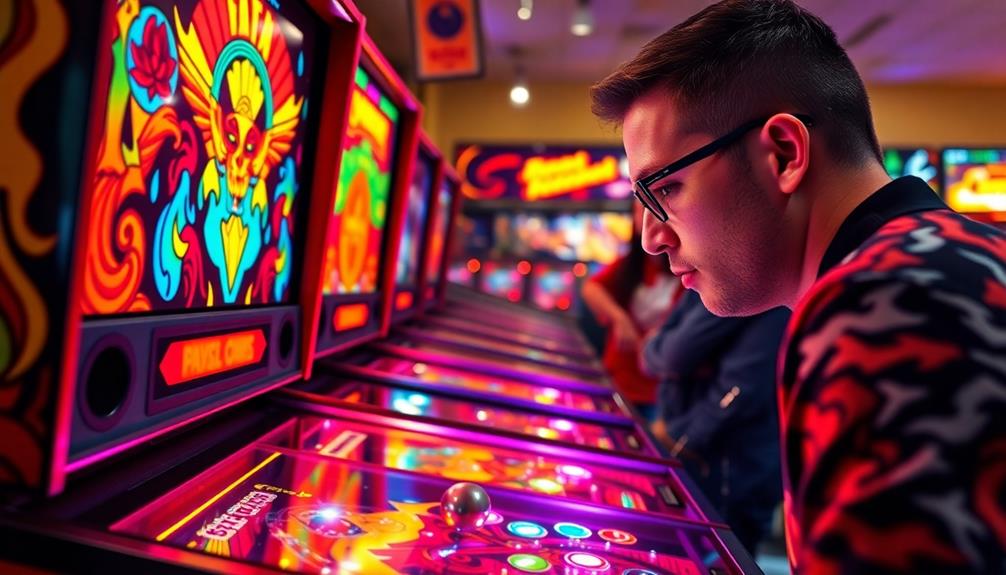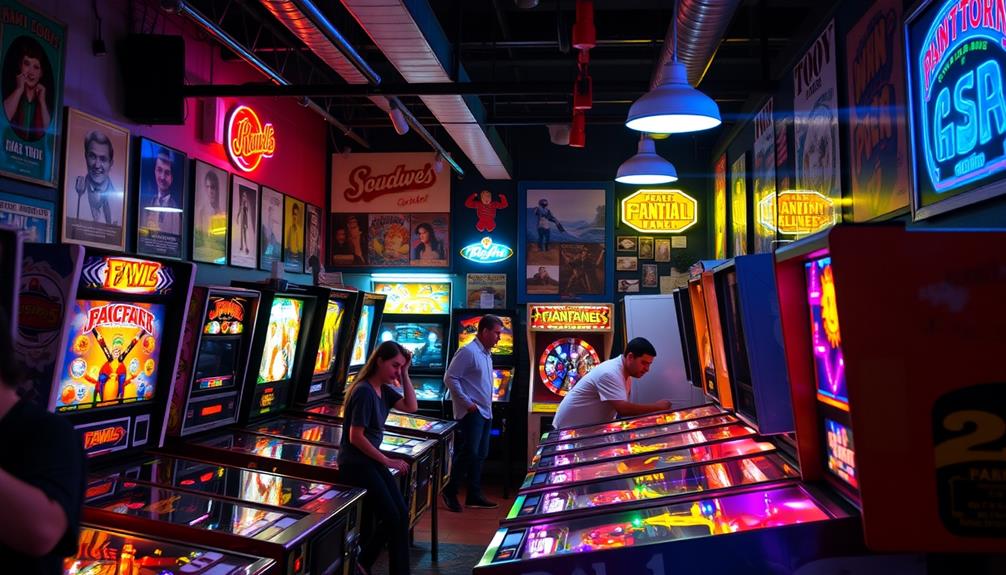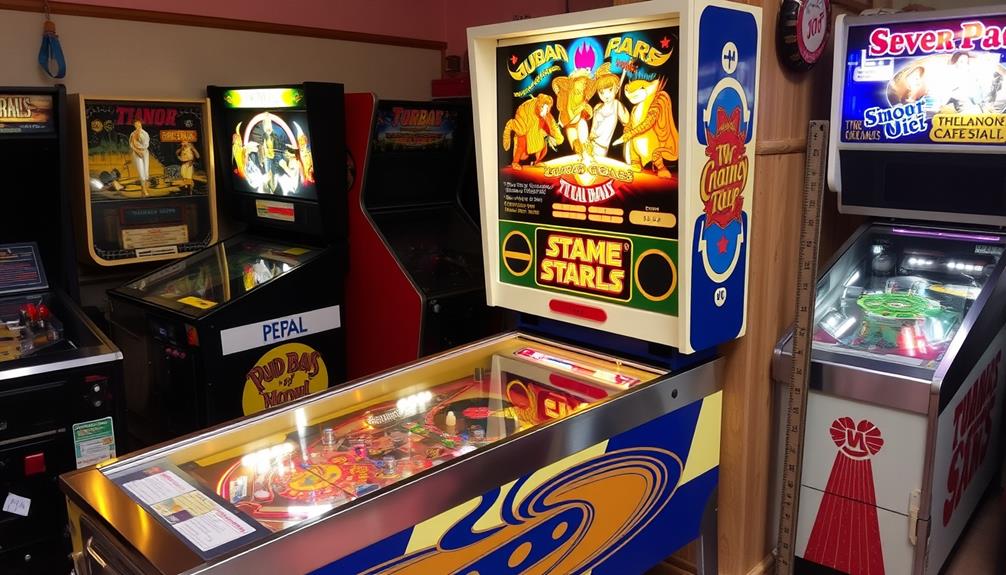Pinball was banned in California primarily due to concerns that it encouraged gambling and vice. In the 1930s, machines with cash prizes raised alarms among the public. In 1939, Los Angeles enacted a prohibition on pinball machines, labeling them as nuisances. Authorities linked pinball to organized crime and youth delinquency, heightening worries about its societal effects. The view of pinball as a game of chance, especially without flippers, fueled these fears. It wasn’t until 1974 that pinball was acknowledged as a game of skill, leading to its legalization. If you’re interested in the evolution of perceptions over the years, there is more to explore. To fully comprehend the situation, it is crucial to delve into the history of pinball laws and the cultural environment surrounding the passage of such regulations. The shift from considering pinball a gambling tool to a skill game reflects changing attitudes towards leisure and fun. Analyzing the development of pinball regulations offers valuable insights into how society confronts new recreational activities and their potential impact on public morals.
If you want to learn more about the history of pinball laws, check out this link: history of pinball laws.
Key Takeaways
- Pinball machines were initially seen as gambling devices due to cash prizes, raising public concern and leading to bans in the 1930s.
- Legal action against pinball began in 1937 in response to fears of its association with organized crime and juvenile delinquency.
- The lack of flippers made pinball perceived as a game of chance, further solidifying its reputation as a gambling vice.
- Los Angeles passed Proposition No. 3 in 1939, officially categorizing pinball machines as nuisances and initiating widespread confiscation.
- Public sentiment and media portrayal linked pinball to crime and moral decay, fueling the movement to outlaw the machines.
Origins of Pinball Regulation
In the 1930s, California's regulation of pinball machines emerged as a response to rising concerns about gambling. Early pinball machines operated similarly to slot machines, offering cash prizes that raised alarm among the public and lawmakers. This concern was compounded by the notion of financial mismanagement and the potential for addiction among players, particularly youth.
Fears about petty gambling and its impact on youth fueled a growing movement against pinball, culminating in the 1939 Los Angeles City Proposition No. 3, which resulted in a ban on these machines. With the backing of public sentiment, the police were empowered to enforce this prohibition rigorously.
The California Attorney General's crackdown in the 1940s further solidified pinball's reputation as a gambling device, leading to widespread enforcement actions against operators. Even with the ban in place, pinball machines continued to operate illegally, contributing to an underground gaming culture in California where enthusiasts still sought the thrill of the game.
It wasn't until 1974 that the California Supreme Court redefined the narrative, ruling pinball a game of skill rather than chance. This landmark decision ultimately overturned the prohibition, paving the way for the eventual resurgence and acceptance of pinball in California.
The Role of Gambling Concerns

Gambling concerns played a pivotal role in the outlawing of pinball machines in California. Early pinball machines operated similarly to slot machines, and they offered cash prizes, causing alarm among authorities. The California Attorney General's office and local officials viewed these machines as a gateway to illegal gambling, leading to widespread bans in public places, particularly in cities like Los Angeles in 1939.
This perception was exacerbated by the intense emotional reactions associated with gambling addiction, mirroring the symptoms of emotional dysregulation seen in individuals with Borderline Personality Disorder (BPD).
As machines lacked flippers, they heightened the perception that they were games of chance rather than skill, further fueling fears of gambling implications. The associations with petty gambling made it easy for the public to see pinball as a tool for organized crime. Authorities believed that police are totally insufficient in regulating these operations, prompting a swift response to eliminate pinball altogether.
The fear wasn't just about the machines themselves but also about the influence on youth and the potential for pinball to become a front for more serious gambling activities. This combination of concerns solidified the arguments for making pinball machines illegal, reflecting a broader societal anxiety about gambling and its impact on communities.
Key Legal Milestones in California

You might be surprised to learn that pinball faced strict legal prohibitions starting in 1937 due to gambling concerns.
During this period, many viewed pinball machines as a means of illicit gambling, which led to their ban.
However, everything changed on June 22, 1974, when the California Supreme Court ruled pinball a game of skill, paving the way for its resurgence.
This critical shift marked a turning point in how the game was perceived and regulated in the state, making it a beloved pastime once again, much like how Gold IRAs offer potential for long-term capital appreciation.
Early Legal Prohibitions
Pinball machines faced swift legal action in California during the 1930s as concerns over gambling and its potential effects on youth and crime spurred lawmakers into action. This period saw a rise in philosophical debates surrounding morality and societal responsibility, echoing ideas from utilitarian thinkers' declarations that emphasized the balance between individual rights and the collective good.
Following the Illinois Attorney General's ban on pinball in 1937, California lawmakers took note, fearing that these games would encourage gambling behavior and undermine societal morals. By 1939, Los Angeles passed Proposition No. 3, officially labeling pinball machines and other coin-operated games as nuisances. This led to the police seizing machines from various establishments, effectively enforcing the ban across the city.
The legal prohibitions reflected a broader societal attitude against gambling, viewing pinball as more than just a game; it was seen as a gateway to vice. For decades, the ban on pinball remained in effect, illustrating a significant clash between entertainment and morality in California.
The classification of pinball as a gambling nuisance not only affected arcade owners but also shaped public perception of the game itself. It wasn't until the landmark ruling by the California Supreme Court in 1974 that pinball was finally recognized as a game of skill, paving the way for its eventual resurgence in the state.
Supreme Court Ruling
The long-standing ban on pinball in California faced a significant challenge in 1974 when the California Supreme Court ruled that these machines were games of skill rather than chance. This landmark decision emerged from a case in Los Angeles, where the court distinguished pinball machines from traditional gambling devices.
By recognizing the skill involved in playing pinball, the ruling paved the way for the legalization of these machines across various cities in California. This change in legal status can be seen as a reflection of the broader cultural shifts toward embracing creativity and innovation in gaming, much like the principles of design thinking that promote user-centric solutions.
As a result, public perception began to shift, moving away from the association of pinball with gambling and delinquency that had persisted for decades. Cities like Los Angeles embraced the change, leading to a newfound acceptance of arcade gaming.
The impact of this supreme court ruling extended beyond California, influencing other states to reconsider their laws surrounding pinball and similar games in the years that followed.
Ultimately, this pivotal decision marked a turning point for pinball in California, allowing players to enjoy the game without the stigma of illegality. It demonstrated that pinball machines could be appreciated for their skill-based gameplay, changing the landscape of gaming culture.
Cultural Perceptions and Stigmas

Throughout the early to mid-20th century, cultural perceptions of pinball shifted dramatically, often painting the machines as symbols of vice rather than entertainment. Initially seen as gambling devices due to their lack of flippers, pinball faced increasing scrutiny during the Great Depression. The cultural stigma surrounding these games intensified, linking them to juvenile delinquency and organized crime.
In cities like Los Angeles, public sentiment turned sharply against pinball, resulting in strict legal prohibitions. Media sensationalism in the 1940s and 1950s further fueled moral concerns, depicting pinball as a corrupting influence on youth. Despite pinball's evolution to include skill elements, the longstanding perception of it as a vice-ridden gambling tool persisted, affecting its acceptance in society.
Here's a breakdown of key influences on pinball's cultural perception:
| Influence | Description |
|---|---|
| Cultural Stigma | Viewed as immoral and corrupting |
| Juvenile Delinquency | Associated with youth misbehavior |
| Gambling Devices | Labeled as games of chance |
| Public Sentiment | Fear of crime linked to pinball |
| Moral Concerns | Concerns about the impact on society |
These factors collectively shaped the narrative that led to pinball's eventual outlawing.
Impact on Arcade Culture

The ban on pinball machines pushed gaming underground, forcing players like you to seek out hidden spots just to enjoy the game.
This underground movement mirrored the challenges faced by tiny house enthusiasts, who often navigate building codes and zoning laws to find suitable locations for their homes.
Many arcades shifted their focus to other entertainment options, which stifled the arcade culture during those years.
However, as public attitudes changed and pinball became legal again, a vibrant community and renewed interest in arcades began to flourish.
Underground Gaming Scenes
In California during the 1930s, pinball's prohibition sparked a vibrant underground gaming scene that thrived in the shadows. This illegal culture attracted enthusiasts who sought hidden locations to indulge in their favorite pastime. You could find players gathered in clandestine arcades or the back rooms of bars, creating a rebellious atmosphere that defied the law.
This underground movement not only demonstrated the community's resilience but also showcased how content relevance and authority are prioritized in holistic SEO within the domain of gaming culture.
The underground gaming community wasn't just about the thrill of playing pinball; it was a place for camaraderie and competition. Here's what defined this unique scene:
- Informal Tournaments: Players organized competitions, showcasing their skills and fostering a sense of belonging.
- Shared Spaces: Underground arcades became social hubs, where friendships formed over shared passions.
- Legacy of Innovation: This thriving culture influenced the design and gameplay of future arcade experiences.
Even though pinball was deemed illegal, its popularity only grew, leading to a rich tapestry of gaming culture that would eventually transform into legitimate entertainment.
The eventual repeal of the ban in 1974 allowed this underground scene to flourish openly, revitalizing public interest in arcades and solidifying pinball's place in gaming history.
Shift to Alternatives
During the ban on pinball in California, many arcade owners turned to alternative forms of entertainment to keep their businesses afloat. With pinball machines pushed underground, you'd see a significant shift toward video games, which required less maintenance and appealed to a wider audience.
This change not only kept arcades alive but also laid the groundwork for a different kind of arcade culture, as unique party options began to emerge within these spaces. As pinball enthusiasts sought to bypass restrictions, underground gaming scenes flourished. Enthusiasts gathered to play and modify machines in private settings, creating a vibrant subculture around pinball, even as it faced prohibition.
Meanwhile, the rise of video games became an integral part of arcade life, providing an engaging alternative that helped maintain foot traffic.
When the ban was eventually repealed, the resurgence of pinball in the 1970s blended classic gameplay with these new technologies. This revitalization reflected a cultural acceptance of arcade games, marking a shift in societal attitudes toward gaming as a legitimate form of entertainment.
Ultimately, the ban inadvertently shaped a diverse gaming landscape, where pinball and video games coexisted and thrived together.
Evolving Public Attitudes
As pinball machines reemerged from the shadows of prohibition, public attitudes began to shift dramatically. Once viewed as instruments of gambling that fueled juvenile delinquency, these machines transformed into symbols of skill and entertainment. This evolution mirrors the broader societal changes in how we perceive games, reflecting a growing recognition of their role in fostering curiosity and happiness. The California Supreme Court's 1974 ruling recognized pinball as a game of skill rather than chance, marking a pivotal moment in arcade culture.
This legal change didn't just lift bans; it rejuvenated local economies and fostered community engagement. With pinball back in the spotlight, arcades became social hubs, offering a space for people to connect and celebrate gaming culture.
- Pinball tournaments flourished, showcasing talent and drawing crowds.
- New arcade businesses emerged, revitalizing neighborhoods.
- Public sentiment evolved, embracing games as legitimate forms of recreation.
These shifts reflect a broader transformation in societal attitudes towards gaming. No longer stigmatized, pinball and other arcade machines now help bridge generational gaps and bring people together.
As you step into a modern arcade, you witness the legacy of those earlier struggles, transformed into a vibrant celebration of skill and community.
The Path to Legalization

The journey to pinball's legalization in California was marked by a series of pivotal moments that changed its perception from a gambling vice to a respected game of skill. In the 1930s, pinball machines were outlawed due to their association with gambling, particularly before the introduction of flippers.
However, everything shifted on June 22, 1974, when the California Supreme Court ruled that pinball is a game of skill. This landmark decision was essential, as it overturned previous bans and paved the way for legalization in Los Angeles. The ruling underscored the importance of recognizing games based on skill rather than chance, similar to how juice diets can be beneficial when balanced with proper nutrition.
Following this ruling, public sentiment began to favor pinball, leading cities across California to reevaluate their positions. In 1976, top player Roger Sharpe demonstrated the skill involved in pinball, further boosting the movement for legalization not just in California but influencing places like New York City, too.
The repeal of the ban represented a significant cultural shift, allowing pinball to thrive and integrate into the burgeoning arcade culture of the late 20th century. Today, you can appreciate pinball as a staple of entertainment, thanks to the efforts that championed its recognition as more than just a game of chance.
Frequently Asked Questions
Why Were Pinball Machines Illegal in California?
Pinball machines were illegal in California due to concerns that they encouraged gambling. Many believed they were games of chance rather than skill, fueling public sentiment against them and leading to widespread legal prohibitions. These bans were eventually lifted in the late 1970s as it became widely accepted that pinball was, in fact, a game of skill. The game has a long history dating back to the 18th century in France, where pinball originated, and has evolved into an iconic arcade game enjoyed by millions worldwide. Today, pinball machines are not only legal in California but also celebrated as a beloved form of entertainment.
Why Did Pinball Get Banned?
Pinball machines were banned due to their gambling associations. Authorities saw them as gateways to crime and delinquency, fearing they'd lead youth astray. Ultimately, societal concerns outweighed enjoyment, leading to widespread prohibitions across cities.
What State Is Pinball Illegal In?
Currently, pinball isn't illegal in any state. You'll find it enjoyed in arcades, bars, and homes across the U.S. So, if you love playing, you can freely indulge in your favorite pastime!
When Was the Pinball Ban Lifted?
You'd think the pinball ban lasted a century, but it actually lifted on June 22, 1974. That's when the California Supreme Court decided pinball's a game of skill, bringing joy back to arcade enthusiasts!
Conclusion
In the end, California's ban on pinball reflects a clash between cultural perception and regulation. Did you know that at its peak, pinball machines generated over $500 million in revenue annually? This statistic highlights not just pinball's popularity but its importance to the arcade culture. As attitudes shifted and the state recognized pinball as a skill-based game rather than pure chance, it paved the way for its eventual legalization, reviving a beloved pastime for gamers everywhere.









